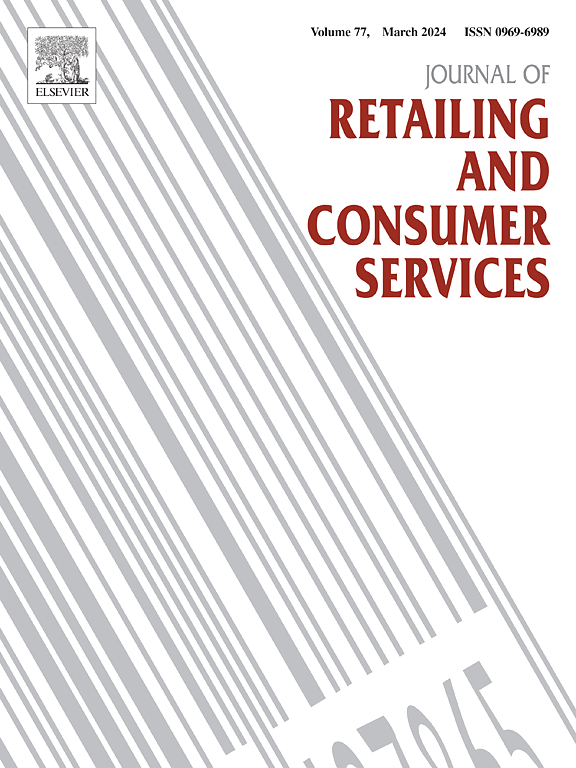The upside of mind wandering in influencing purchasing intention: A conditional process analysis of the moderating role of temporal distance and mediating effects of memory
IF 13.1
1区 管理学
Q1 BUSINESS
Journal of Retailing and Consumer Services
Pub Date : 2025-10-09
DOI:10.1016/j.jretconser.2025.104555
引用次数: 0
Abstract
Despite the prevalence of mind wandering during product information processing, existing research has predominantly focused on its negative effects, overlooking its potential positive impact on purchase intention. This paper addresses this gap by investigating when and how mind wandering can serve as a marketing resource to enhance purchase intention, specifically examining the interaction between mind wandering and temporal distance on purchase intention and the mediating role of gist and verbatim memory. Using a multi-method approach, we conducted three studies employing secondary sales data (n = 808), randomized controlled experiments (n = 1524), and eye-tracking validation techniques. Results consistently demonstrated that under distal temporal distance, higher levels of mind wandering significantly increased purchase intention, mediated by enhanced gist memory and reduced verbatim memory. This effect was non-significant under proximal temporal distance conditions, where neither high nor low mind wandering significantly affected purchase intention, revealing important boundary conditions for mind wandering's influence on consumer behavior. These findings contribute to theory by repositioning mind wandering from a cognitive liability to a potential marketing asset and extending memory-based decision-making models to attention fluctuation contexts. Practically, the research provides actionable insights for marketers facing consumer attention scarcity. Companies can leverage natural mind wandering patterns by targeting high mind wanderers with distal-framed promotions, emphasizing abstract product benefits for future-oriented purchases, and adapting messaging strategies to consumer attention states. This research opens new avenues for understanding the adaptive functions of mind wandering in consumer decision-making and offers evidence-based strategies for transforming attention challenges into competitive advantages.
走神对购买意愿的影响:时间距离和记忆中介效应的条件过程分析
尽管在产品信息加工过程中走神现象普遍存在,但现有的研究主要集中在走神的负面影响上,忽视了走神对购买意愿的潜在积极影响。本文通过考察走神在何时以及如何作为一种营销资源来增强购买意愿来弥补这一空白,特别是考察走神与时间距离对购买意愿的交互作用以及要点记忆和逐字记忆的中介作用。采用多方法方法,我们采用二手销售数据(n = 808)、随机对照实验(n = 1524)和眼动追踪验证技术进行了三项研究。结果一致表明,在远端时间距离下,高水平的走神显著增加了购买意愿,其中介是主旨记忆的增强和逐字记忆的减弱。在近端时间距离条件下,这一效应不显著,在近端时间距离条件下,高、低走神对购买意愿的影响均不显著,揭示了走神对消费者行为影响的重要边界条件。这些发现有助于将走神从认知负担重新定位为潜在的营销资产,并将基于记忆的决策模型扩展到注意力波动环境。实际上,该研究为面临消费者注意力稀缺的营销人员提供了可操作的见解。公司可以利用自然的走神模式,通过远程框架的促销来瞄准高度走神的人,强调面向未来购买的抽象产品的好处,并根据消费者的注意力状态调整信息传递策略。本研究为理解走神在消费者决策中的适应功能开辟了新的途径,并为将注意力挑战转化为竞争优势提供了循证策略。
本文章由计算机程序翻译,如有差异,请以英文原文为准。
求助全文
约1分钟内获得全文
求助全文
来源期刊
CiteScore
20.40
自引率
14.40%
发文量
340
审稿时长
20 days
期刊介绍:
The Journal of Retailing and Consumer Services is a prominent publication that serves as a platform for international and interdisciplinary research and discussions in the constantly evolving fields of retailing and services studies. With a specific emphasis on consumer behavior and policy and managerial decisions, the journal aims to foster contributions from academics encompassing diverse disciplines. The primary areas covered by the journal are:
Retailing and the sale of goods
The provision of consumer services, including transportation, tourism, and leisure.

 求助内容:
求助内容: 应助结果提醒方式:
应助结果提醒方式:


